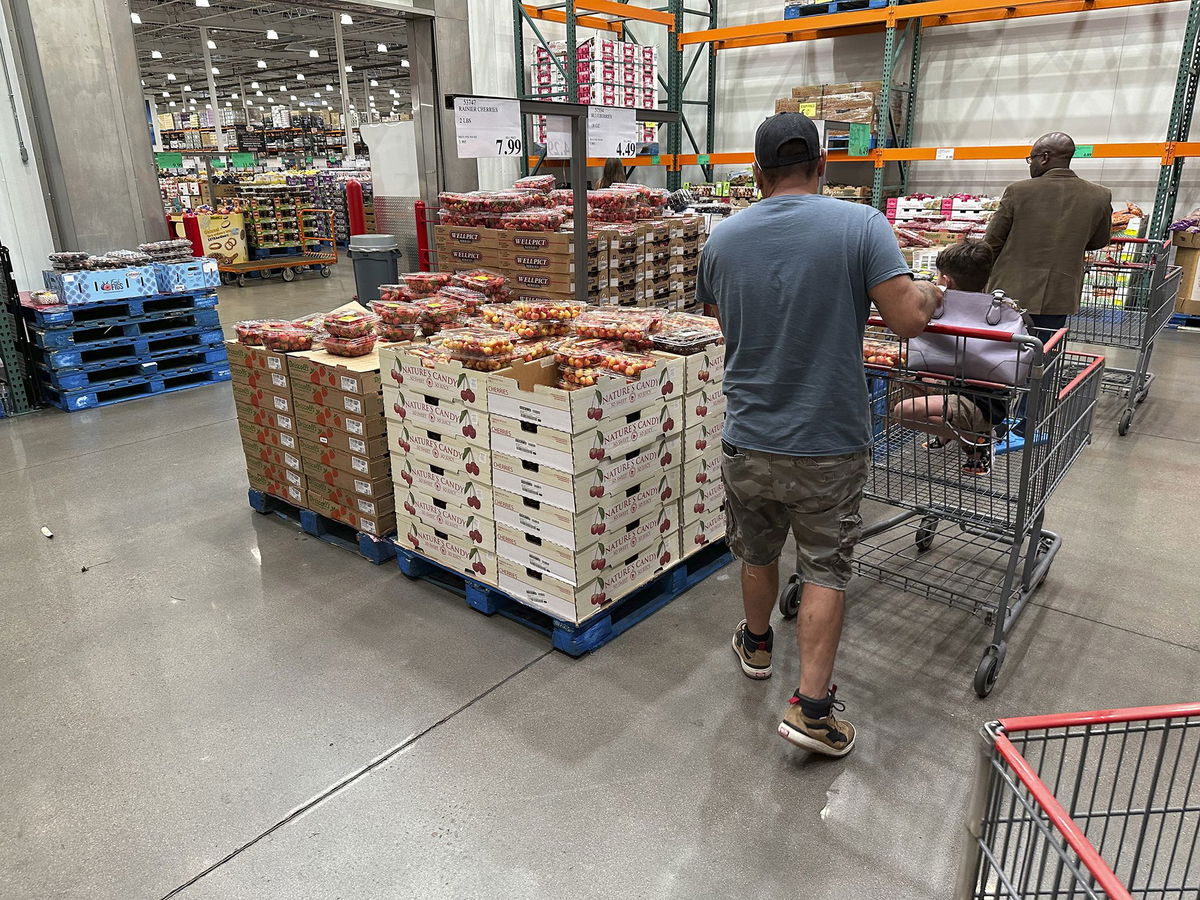US retail spending picked up sharply in July

Shoppers peruse a display of Rainer cherries while pushing carts through a Costco warehouse Tuesday
By Bryan Mena, CNN
Washington, DC (CNN) — Spending at US retailers rose in July at a much faster pace than in the prior month, a combination of both strong demand among American consumers and higher prices because of elevated inflation. It was also the fourth straight month that retail sales increased.
Retail sales, which are adjusted for seasonality but not inflation, rose 0.7% in July from the prior month, the Commerce Department reported Tuesday. That was a faster pace than the previous month’s upwardly revised 0.3% gain and above economists’ expectations of a 0.4% rise, according to Refinitiv.
Spending rose on nondurable items, such as clothing and sporting goods. Sales at restaurants and bars rose a robust 1.4% in July from June.
Meanwhile, sales of durable goods — defined as products meant to last at least three years — slipped. Sales at furniture stores fell 1.8% in July from June and declined 1.3% at electronics and appliance stores during the same period.
Gas prices recently climbed to their highest level in nearly 10 months, which can influence the Commerce Department’s retail-sales figures. Excluding spending at gasoline stations, retail sales rose 0.8% in July from the prior month.
The figures reflect continued resilience from US consumers in the face of higher interest rates and still-high inflation. Retail giants such as Walmart, Target and TJ Maxx parent company TJX report quarterly earnings this week, which could offer some clues on the state of the US consumer.
“Inflation still plays a role – consumers on the whole are still spending more in order to get less,” wrote Nikki Baird, vice president of strategy at retail technology company Aptos, in an analyst note. “But even with rising debt and high interest rates, July did not appear to see any blanket pullback from consumers, which may not come until student loan payments resume in September.”
Inflation has slowed over the past several months, but it remains above the Fed’s 2% target. The Consumer Price Index, a closely watched inflation gauge, rose 3.2% in July from a year earlier, picking up for the first time in more than a year, but well below the four-decade high from June 2022. The Fed’s preferred inflation gauge — the Personal Consumption Expenditure price index — rose 3% for the 12 months ended in June, easing from May’s 3.8% increase.
Barbie, Taylor, Beyoncé
The US economy has displayed remarkable resilience this summer, despite 11 interest-rate hikes since the Federal Reserve began its inflation fight in March 2022. Americans spent big to watch the smash-hit “Barbie” film, to attend concerts by Taylor Swift and Beyoncé, and on travel. Wall Street bankers and Fed economists have recently revoked their estimates of a US recession because of the economy’s surprising strength this summer. While the US job market has cooled steadily in recent months, it remains on strong footing, which bodes well for the broader economy since Americans are still getting hired and seeing their wages continue to grow.
“There is a greater sense of optimism regarding the economy and inflation, but consumers are still acting with financial prudence amid elevated prices and interest rates,” wrote Gregory Daco, chief economist at EY-Parthenon, in a note. “Slower employment and disposable household income growth in the coming months will likely mean ongoing consumer cautiousness, but we don’t foresee a retrenchment.”
Economic headwinds lie ahead with the resumption of student loan payments and the possibility of one more rate hike from the Fed. Central bankers meet next month to decided whether to hold interest rates steady or hike for the 12th time this cycle. Some economists argue that the full effects of the Fed’s aggressive rate hiking campaign haven’t been felt yet.
And there are signs from some retailers that demand has been weakening, which could eventually eat into their bottom line.
“Goods consumption is holding up even as services spending has taken up an increasing share of household’s wallets. But for most retailers, it’s year-over-year comparisons that matter,” Wells Fargo economists wrote in an analysis Tuesday. “Retailers that sell their wares online and bars & restaurants are doing very well by this measure, but nearly half (five of 13) of retailers have seen sales slip below where they stood a year ago when adjusted for inflation, which instead speaks to the weakening demand profile often experienced by many retailers today.”
The-CNN-Wire
™ & © 2023 Cable News Network, Inc., a Warner Bros. Discovery Company. All rights reserved.